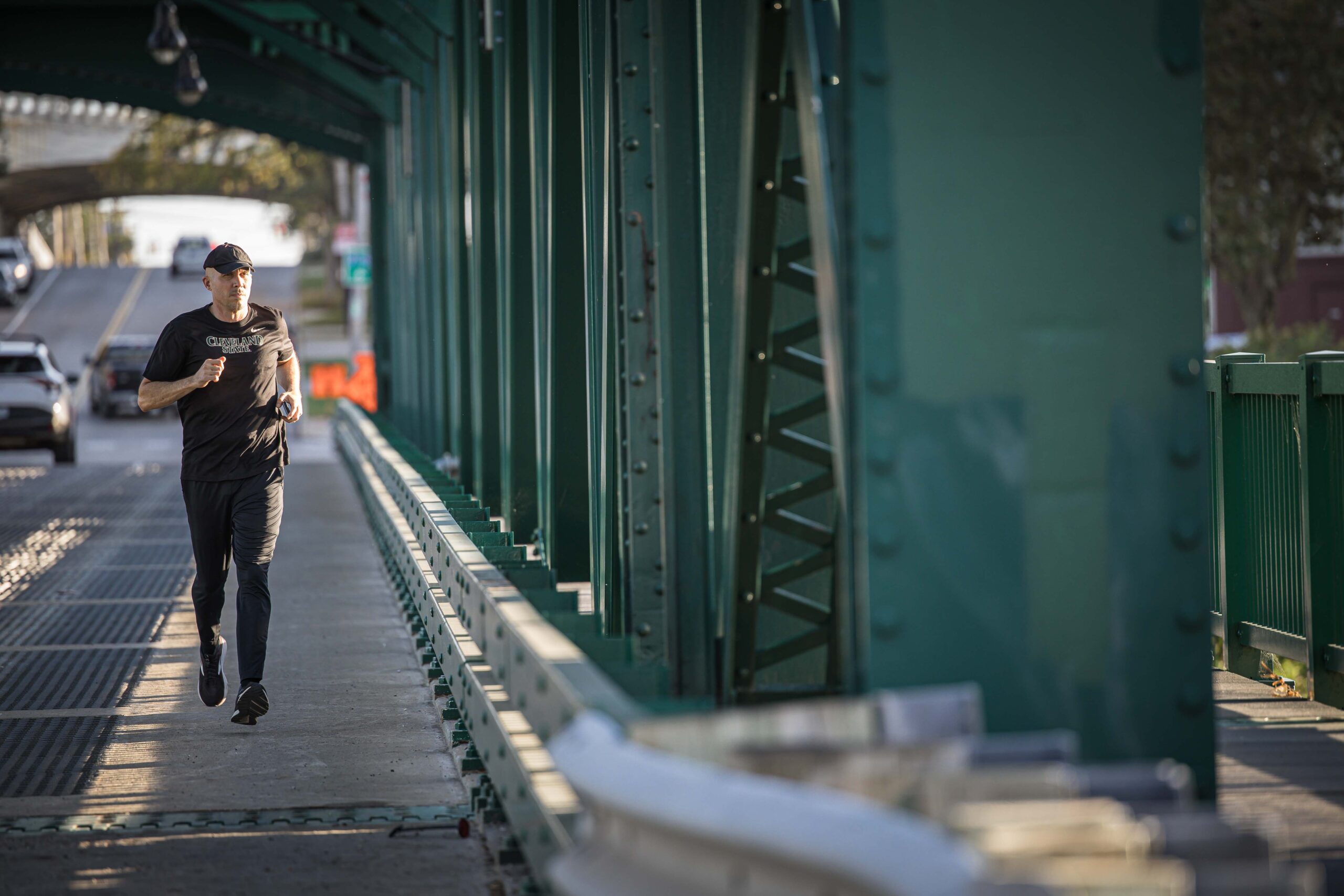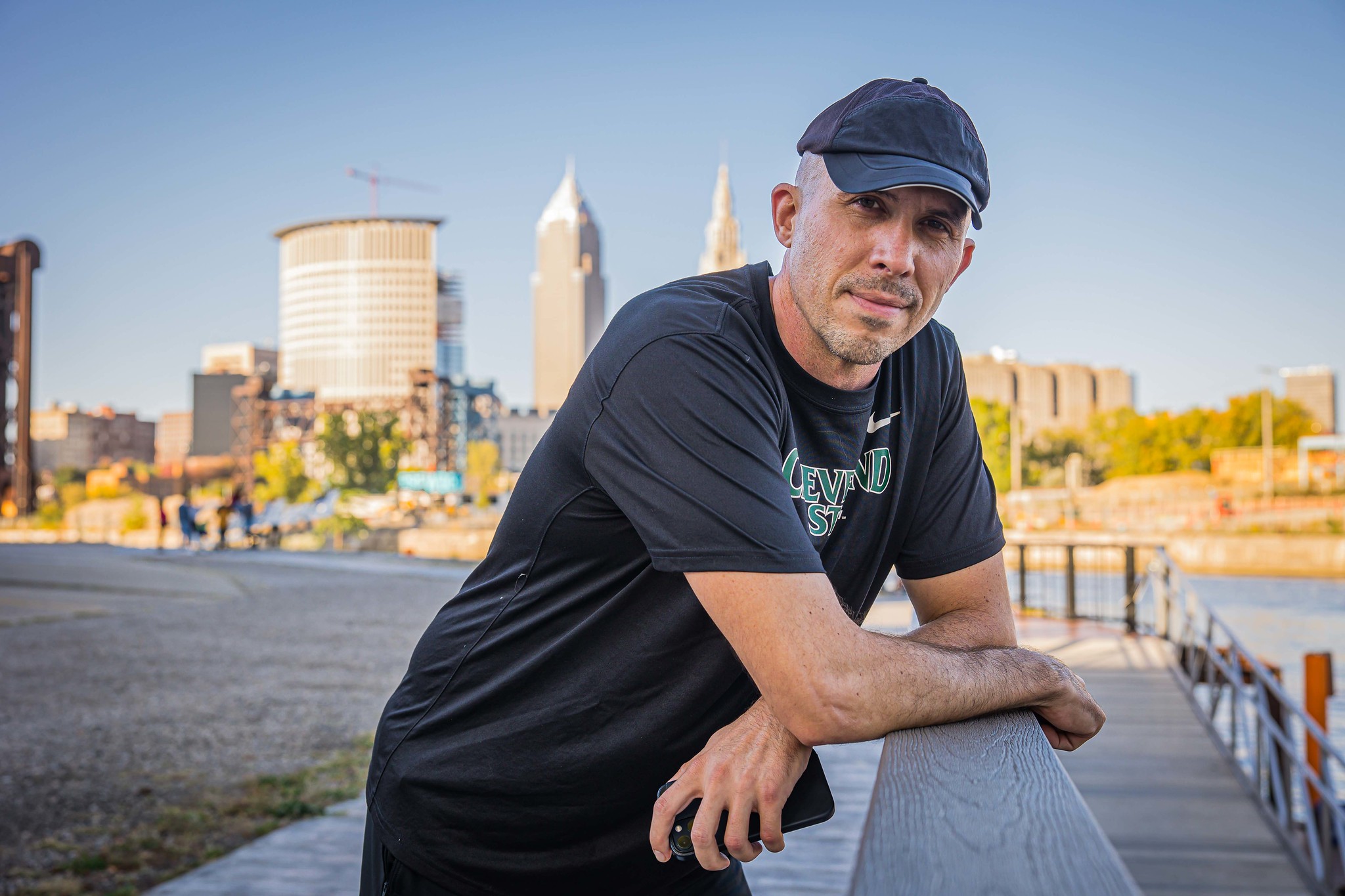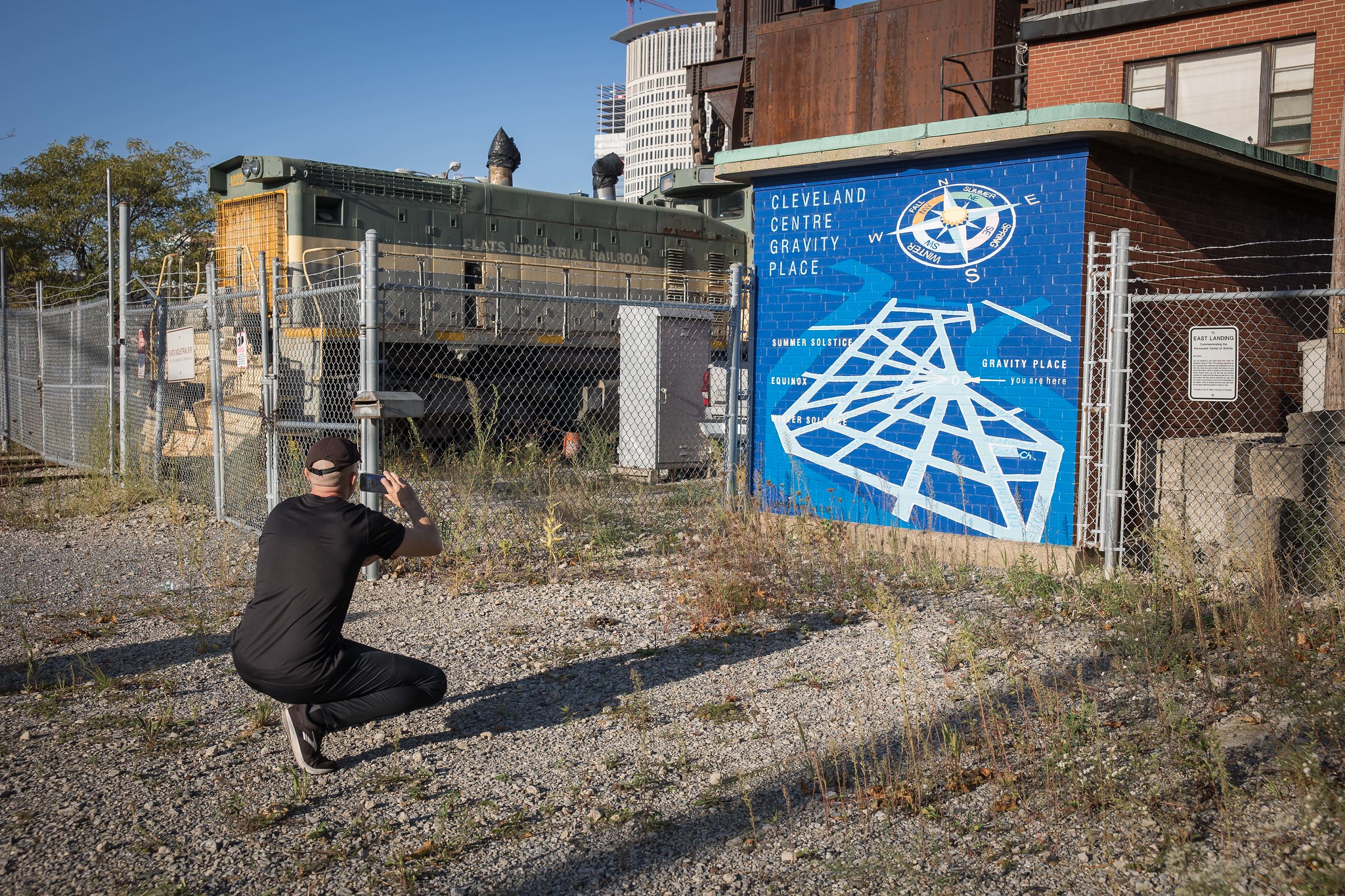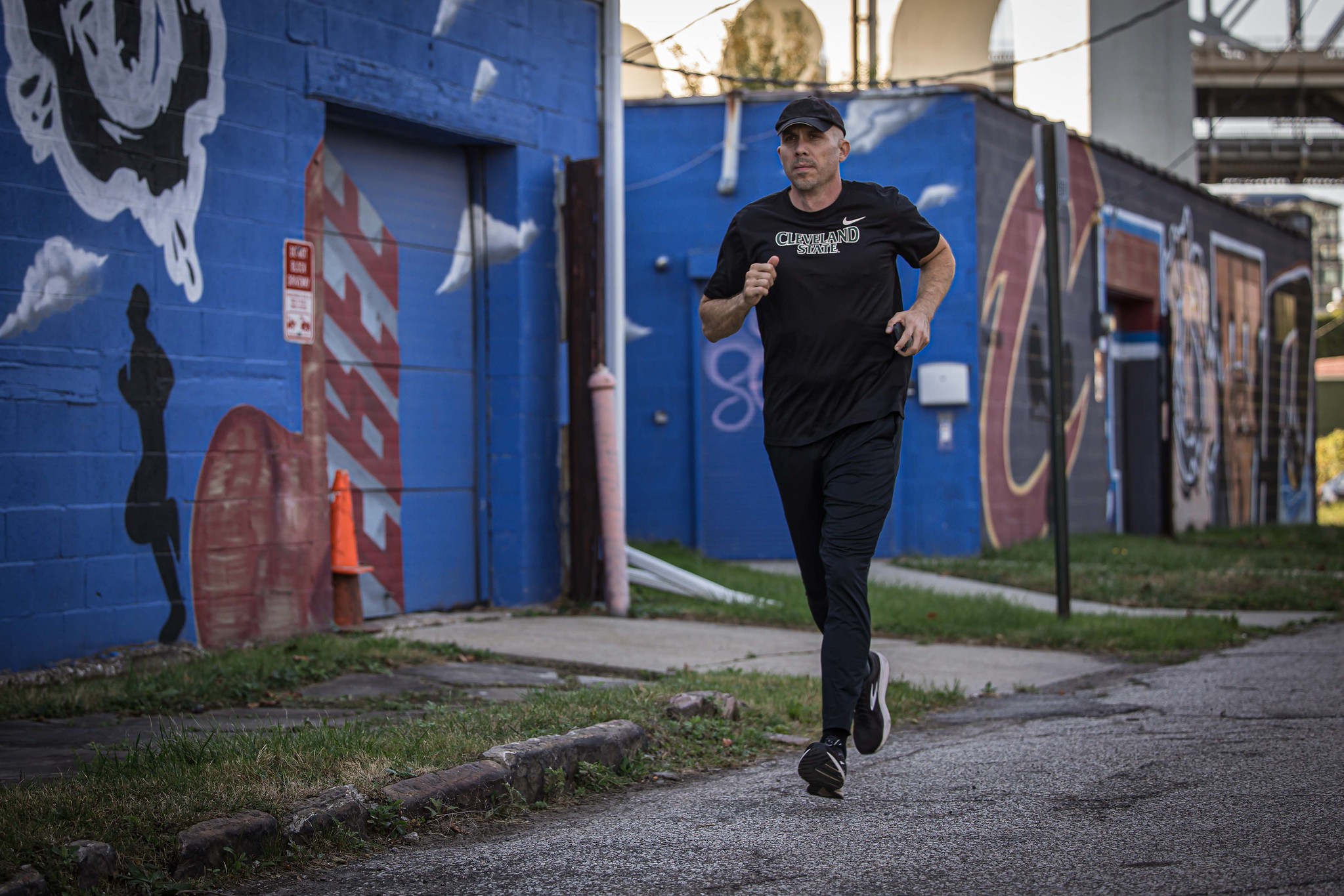Roads Less Traveled

Few, if any, Cleveland residents know their city through and through. Sure, they live and work in their respective neighborhoods, but who can say they’ve explored every street? Come 2025, Phil Kidd, a recent student in the Levin School of Urban Affairs, will be able to say just that.
We met up with Phil Kidd on Columbus Road in the Flats of Cleveland, near a bridge that crosses the Cuyahoga River, on a warm evening. Catty-corner to us was C4, a CrossFit gym with a class working out on rowing machines. Next door at The Foundry, a rowing and sailing organization, high school students were prepping their boats for the water. And a group of what seemed to be tourists gathered at the river’s edge for impromptu photoshoots at one of the locations of what is now the iconic Cleveland signs.
But we were there for Phil. We wanted to capture him in his element. On Cleveland’s streets. Taking in its history. Up close and personal.
Almost immediately, he couldn’t help himself. It was almost as if a dam of information had broken. He was the teacher; we were the students. And class was in session. He told us how where we were standing was one of the oldest parts of the city. He told us about the origins of nearby street names. How a building near us stood on the site of what was St. Mary’s on-the-Flats, the oldest Catholic church in the area. How a near-civil war erupted between eastsiders and westsiders because of that Columbus Road bridge just steps from us.

You’d think he was a lifelong Clevelander having amassed his knowledge throughout decades of living here. But he’s not. He moved from Youngstown to Cleveland about a year before the pandemic in 2020. And the reason he knows so much is because he’s committed himself to run every single street in the city. Phil estimates that’s about 1,300 miles. By the time you read this story, he will have completed well over half of his journey.
Phil documents each of his runs on everystreetcleveland.com, a blog that’s garnered both local and national attention. His first post back in June 2020 — “And We’re Off” — has all the eagerness you would expect from someone embarking on an exciting new project, especially one no one else has ever accomplished.
“Today starts the journey – to run every street in the city of Cleveland, Ohio. I have no idea how this will go,” he wrote.
“There’s a feeling of ‘do-ableness’ but also an overwhelming sense of naivete.”
Many of us who picked up pandemic hobbies — think breadmaking, refurbishing furniture, knitting — have long moved on. But that’s not the case with Phil. Talking with him now, well over three years after he started, and you’ll see he hasn’t lost any of that initial optimism. If anything, his commitment has only deepened.
He works for the City of Cleveland as a complete and green streets and trails coordinator. He’s the one responsible for new bike lanes on the road, pedestrian clocks, enhanced crosswalks, lane reductions, tree lawns, tables, and benches. He also helps manage Cleveland’s trail projects, from neighborhoods to the lakeshore. So, running Cleveland’s streets gives him a unique perspective of the landscape he’s charged with improving and shaping for years to come.
“It’s kind of coincidental that I started the [running] project before I started this job,” he said.
“It’s really helped me…because I have context for all of these locations where we’re working on different roadway projects.”
That’s because Phil isn’t just running the streets. He’s learning the streets, delving deep into the stories of the past. Before any of his runs, he maps his routes and extensively researches the history, the landmarks and how the area has transformed through the years.


Back in May, he started the first leg of his run in the Union Miles neighborhood. Readers of his blog learned how on one of the streets — East 147th — Jesse Owens, American track and field Olympian, once lived. Just south in the Lee Seville area, he passed the house where Author Johnson, Ohio’s first Black mayor, lived. It has since been designated a city landmark. “That’s a lot of notable Black history for one city street,” he writes. He passed simple brick homes. Vacant buildings, ripe for rehabilitation. All while stopping to soak in what once was, admiring what is, imagining what could be.
At the time he started the project, Phil was hoping to break up the monotony of the quarantines and isolation of 2020. He thought it might give people locked away in their homes something interesting to follow. And as a relatively new transplant to the area, having accepted a job as special projects manager for a community development organization on the west side, it was an opportunity to get to know his new home. Plus, he’s a city planner by trade, and also by heart.
What he’s learned is that for all that Cleveland has lost — stunning architecture, housing, and some of its once vibrant neighborhoods — there’s a lot left intact, and it tells an incredible story.
“You can see the culture of Cleveland in a physical manifestation layered in different neighborhoods, and almost by concentric rings in some ways,” he said.
Phil can see how city planning has shaped the city for better or worse. He marks the ways some of those decisions currently hamper revitalization efforts. But he also notes how city officials are now turning an eye to prioritize areas that have long been ignored.
And then there’s the art. Not the formally commissioned works, but the stuff most Clevelanders won’t ever see. In the alleys and on the side streets. Born from the lived experiences of city residents. The highs, the lows, the losses, the loves, and everything else in between.
Phil anticipates he has about two years left in his running project. He’s busy. Really busy. If you follow him on X (formerly known as Twitter), you’ll see posts where he’s attending lectures about making Cleveland a livable city. There’s one where he’s back in Youngstown, giving Columbia University business school students the lay of the land. In several, he’s planting trees with the Cleveland Tree Coalition. And then also he’s a man about town. At the Happy Dog. Or grabbing a burger at Stevenson’s in North Collinwood. Or running with one of his running groups.
He plans on ending his odyssey in the Columbus Peninsula where we met up with him in the Flats. Only he called it the “Cleveland Centre Historic District.” Who among us knew that bit of trivia? Phil, that’s who. It’s something only someone like him — brimming with city history — would know.
And when he’s done, he’ll mark the occasion with a party at one of the bars down by the river and show photos from his runs.
“As far as projects after that? Not sure,” he said.
“Maybe I’ll try to run from Cleveland, Ohio, to Cleveland, Georgia which is close to where I lived for a few years in what seems like a lifetime ago.”
